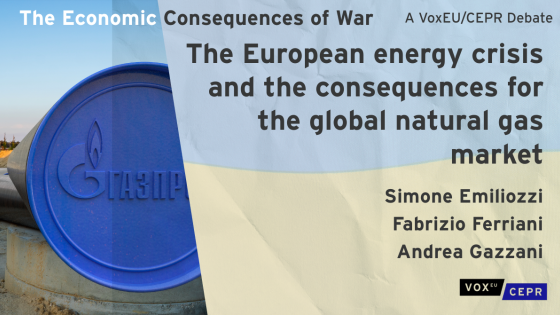Since 2005, the shale boom has been responsible for a large increase in the production of natural gas in the US. Recent research has delved into the impacts of the shale boom on various aspects of the economy, including the environment. The verdict to date seems to be that there is both good and bad news (e.g. Hausman and Kellogg 2015, Newell and Raimi 2015, CBO 2014).
One important consequence of the shale boom that everybody seems to agree on is the change in the relative price of fossil fuels, which has a big impact on the electricity sector given that fossil fuels are the dominant input into electricity generation. While the increased production of natural gas drove down the price paid by the electric power sector by 77% between June 2008 (peak) and April 2012 (trough), the price paid for coal exhibited a clear upward trend and almost doubled between 2003 and 2012 (Figure 1).
Figure 1. Monthly prices of natural gas and coal for the electric power sector

Source: EIA (2015), Table 9.9.
This change in the relative price of the two fuels, combined with environmental policies targeting coal-fired generation – with the most recent and important one being the Clean Power Plan Final Rule – has been accompanied by a notable change in the choice of fuel for electricity generation. In 2003, 51% of electricity was generated using coal and only 17% was generated using natural gas. By 2012, the share of gas in electricity generation jumped to 30%, while that of coal fell to 37% (EIA 2015, Table 7.2a).
The impact of the shale gas boom on the electric power sector has been the subject of numerous studies (Cullen and Mansur 2014, Fell and Kaffine 2014, Linn et al. 2014). In a recent paper (Knittel et al. 2015), we contribute to this literature by quantifying short-term coal-to-gas switching decisions by different types of electricity generators in response to changes in the relative price of the two fuels.
Heterogeneity with respect to the change in the relative price of coal and natural gas
Our work is the first to document heterogeneity in the responses to changes in the relative price of coal and natural gas for the following three types of electricity generators: investor-owned utilities (IOUs) and independent power producers (IPPs) in restructured markets coordinated by Independent System Operators (ISOs), and IOUs in traditional vertically-integrated markets. Our interest lies exclusively on entities with both coal-fired and gas-fired generation for the period 2003-2012.
We first investigate how the share of natural gas – out of coal and natural gas used for electricity generation – responds to changes in fuel prices across the three groups. We find that IOUs in traditional markets respond more to fuel prices than both IOUs and IPPs in ISO markets. For traditional IOUs, the elasticity of the share of natural gas with respect to the price of coal is 1.7, while that with respect to natural gas is -1.2. The same elasticities for both IOUs and IPPs in ISO markets are smaller in magnitude and statistically indistinguishable from zero.
What explains the heterogeneity in the response of electricity generators?
A plausible explanation behind the difference in fuel-cost responses is the difference in investment in gas-fired generation between the traditional and restructured markets around the time of the shale boom. There are two reasons for the difference in investment rates. On the one hand, the restructuring process appears to have reduced the incentives for ISO market participants to invest in gas-fired capacity, possibly due to market power, which limited their ability to respond to changes in the relative price of the two fuels. On the other hand, traditional markets may have invested more in gas-fired capacity because of the Averch-Johnson effect.
Using a difference-in-difference regression, we find reductions in gas-fired capacity investment for the most advanced technology (combined cycle) by ISO market participants relative to investment in traditional markets post restructuring. A graphical illustration of the differences in investments is given in panel (a) of Figure 2. Each point on the series is an average of the nameplate capacity across multiple states in a given year with the blue (red) line identifying states that did not restructure (restructured). The black vertical lines identify the restructuring period 1997–2004.
Figure 2. Illustrating difference in investment in gas-fired capacity

Environmental implications of the heterogeneity in the response of electricity generatorsThis lower investment in the restructured markets led to two effects that limited the shift toward gas-fired generation. First, fewer gas-fired electric generating units (EGUs) are available to switch to if the price of natural gas relative to the price of coal falls. Second, existing gas-fired units are, on average, older and less efficient requiring more energy input per megawatt hour of electricity (MMBtu/MWh) and, hence, less competitive compared to coal-fired electric generating units making short-term switching more difficult. Panel (b) of Figure 2 compares the heat-rate distributions for IOUs in traditional and ISO markets using firm-level data, illustrating that there is a larger mass of less efficient units for IOUs in ISO markets; we draw similar conclusions for ISO IPPs. Documental evidence discussed in the paper provides additional support for our findings.
Our results based on the fuel consumption share of natural gas indicated heterogeneity in the response to fuel prices for different types of generators, with traditional IOUs being more responsive than both IOUs and IPPs in ISO markets. The last part of our analysis is dedicated to assessing the implications of these differences on CO2 emissions.
We find that a drop in the price of natural gas decreases CO2 emissions due to substitution away from coal, which has almost double the CO2 emissions of natural gas. In addition, emissions respond more to coal prices than to natural gas prices. Based on the estimates from the econometric models employed, we perform a simple back-of-the-envelope exercise in which we translate the drop in gas prices to a drop in CO2 emissions. We first construct a monthly index for the price of natural gas paid by the generators in our sample (see the blue line in Figure 3). Subsequently, we translate the index of natural gas prices into an index of CO2 emissions. Using firm-level data, traditional IOUs experience a decrease of 33% in their emissions relative to their June-2008 levels (green line, both panels), while the ISO IOUs and IPPs experience a drop of 19% (red line, panel a) and 17% (red line, panel b), respectively.
Figure 3. Back-of-the envelope reduction in CO2 emissions

In Figure 4, we provide actual (blue line) and back-of-the-envelope hypothetical (red line) emissions eliminating the heterogeneity in responses to the price of natural gas. That is, we ‘force’ the response of CO2 emissions for ISO IOUs and IPPs to be the same as that of traditional IOUs. The dashed red lines on either side of the back-of-the-envelope hypothetical emissions correspond to 95% bootstrap confidence intervals. Had the ISO IOUs exhibited the same response to the price of natural gas as traditional IOUs, emissions would have dropped to 66% as opposed to 81% of their 2008 levels (panel a). Similarly, we see gains of 16 percentage points in the case of ISO IPPs (panel b); emissions would have dropped to 62% as opposed to 78% of their 2008 levels.
Figure 4. Back-of-the envelope (BOE) reduction in CO2 emissions, eliminating heterogeneity

Concluding remarks
Our research revealed that investor-owned utilities (IOUs) in traditional vertically integrated markets were more sensitive to changes in the relative price of coal and natural gas than investor-owned utilities and independent power producers (IPPs) in restructured markets, and they were more likely to switch from coal-fired to gas-fired generation to take advantage of the lower natural gas prices due to the shale boom. The documented heterogeneity in the generators’ response to fuel prices has material implications for their CO2 emissions. The drop in the price of natural gas between June 2008 and the end of 2012 translates to as much as a 33% reduction in CO2 emissions for IOUs in traditional markets, but only up to a 19% reduction for IOUs and a 17% reduction for IPPs in restructured markets. Significant gains in emissions reductions would have been possible in the absence of heterogeneity in response to the price of natural gas.
References
CBO (2014), “The Economics and Budgetary Effects of Producing Oil and Natural Gas from shale,” Congressional Budget Office, Congress of the United States.
Cullen, J and E Mansur (2014), “Inferring Carbon Abatement Costs in Electricity Markets: A Revealed Preference Approach Using the Shale Revolution,” NBER Working Paper 20795.
Energy Information Administration (EIA) (2015), EIA Monthly Energy Review.
Fell, H and D Kaffine (2014), “A one-two punch: Joint effects of natural gas abundance and renewables on coal-fired power plants,” Colorado School of Mines WP 2014-10.
Hausman, C and R Kellogg (2015), “Welfare and Distributional Implications of Shale Gas,” NBER Working Paper 21115.
Knittel, C, K Metaxoglou, and A Trindade (2015), “Natural Gas Prices and Coal Displacement: Evidence from Electricity Markets,” NBER Working Paper 21627.
Linn J, L Muehlenbachs, and Y Wang (2014): “How Do Natural Gas Prices Affect Electricity Consumers and the Environment?,” Resources for the Future Discussion Paper 14-19.
Newell, R and D Raimi (2015), “Shale Public Finance: Local Government Revenues and Costs Associated with Oil and Gas Development,” NBER Working Paper 21542.









